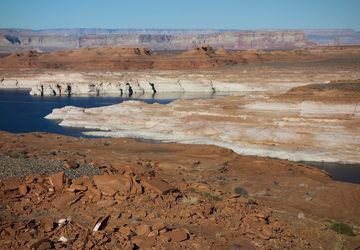Harnessing Sunlight in the Wilderness of Southeast Alaska
With support from the Lane Center, Stanford students install solar energy panels on Alaska's Inian Islands, a little-known rural western community.


Southeast Alaska, with Glacier Bay National Park in white, Tongass National Forest in green, and Cross Sound – the location of the Inian Islands — shown by a star. Map courtesy of the Inian Islands Institute
While the Inian Islands Institute relied on hydroelectric power, its small hydro-generator was entirely dependent on rain; supplementing with solar energy would ensure consistent operation on sunny days too. Farley had learned the fundamentals of solar power during the Lane Center Sophomore College class in Hawaii. Twarog had an electrical engineering background and had taken some circuits classes at Stanford, but neither student had designed or installed solar panels before. The enterprising students were tirelessly up to the task, however, and they succeeded in their installation of a one-kilowatt solar array, helping the Institute achieve their fossil-free mission while gaining valuable, hands-on experience in clean energy.
We asked Farley and Twarog to share more about their experience in Southeast Alaska. Below are some of their thoughts on the inspiration behind their project, their interests in renewable resources, and their desire to learn alongside and within a self-sufficient, sustainable community in the rural West.
Q&A with Vanessa Farley, Product Design '22, and Cam Twarog, Electrical Engineering, '22
What was the basis for your interest in an isolated, off-the-grid Alaskan community? Are you both from there, or did you go specifically for this project?
Farley and Twarog: We would like to acknowledge that the Inian Islands and the surrounding lands and waters are not our own, nor do they belong to the Institute. The Huna Tlingit people lived and thrived on these lands and waters for thousands of years before they were stolen and occupied by European colonizers.

Twarog: I grew up in rural New Hampshire and after school I want to live and work in rural New England, so working in an isolated community is aligned with later goals for me. I also grew up in a family that was actively involved in clean energy advocacy, so I’ve always been surrounded by topics relating to energy. I’m particularly interested in the use of solar and other renewables for clean power generation in rural or off-grid communities. Once we found out that the Inian Islands Institute had solar panels that they needed to be installed, I was immediately excited at the opportunity to live and work in such a place where even simple tasks take much more resourcefulness and creativity than in urban settings. Vanessa and I were alread living in Alaska working with WWOOF, so this solar project was a relatively local way to combine electrical engineering and general construction skills.
Vanessa and I were also interested in learning skills beyond installing solar panels, and the Inian Islands Institute has an incredible caretaker, Colter Barnes, who is so willing to share his knowledge about fishing, tanning hides, construction, crabbing, etc. We got to help on so many different projects that were unrelated to solar, but helped us to learn new skills beyond solar panel installation. In addition to this, all of the meat that we ate was either crab, venison, or fish that was fished and hunted around the island. All of the vegetables were grown on the island. We ended up having a really intimate relationship with the land that we were living on that neither of us expected, but were happy to welcome. There is also an environmental science significance to this island, as it is located in an area of water that is home to dense populations of whales, sea lions, sea otters, salmon, halibut, etc. On short kayak outings, we would paddle next to pods of sea lions and watch humpback whales breach from afar.



Twarog: I have a background in electrical engineering, but haven’t taken classes that specifically go over solar panel design and installation. When we started looking into installing the panels ourselves, it turned out that it was actually pretty simple to wire panels together. The main difficulty was in figuring out what combinations of panels to wire together to minimize power loss, but with some online resources this was pretty easy to figure out. My circuits classes at Stanford definitely made me more comfortable working around electricity and electrical components in general. That being said, much of the work that we were doing with electricity was closer to work that an electrician would do. There are additional dangers when working in a breaker panel and high voltage/current electrical systems.
What would you say the significance or larger impact of this work is? Why was it important (not just for you in developing your skills, but for the community you served? The institute?)
Farley and Twarog: Before we installed the solar panels, the Institute relied on hydroelectric power for all of its energy needs. Hydropower is a great match for Southeast Alaska, which receives around 200 inches of precipitation each year. However, power is often unreliable during summer months when the island can go days without rain. The solar power from our installation kicks in on sunny days when the hydropower isn’t generating enough, offering increased energy reliability for the island. For dry, sunny stretches, our panels can provide enough power to turn on the water heater or to heat an additional building. It’s pretty exciting knowing that the result of our work will be felt for years to come on the Inian Islands.


